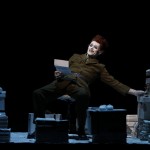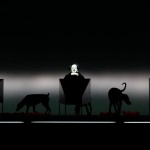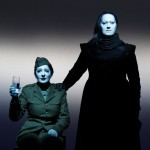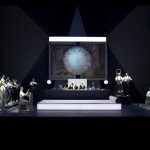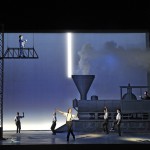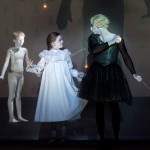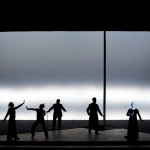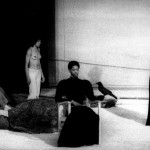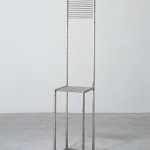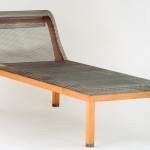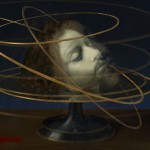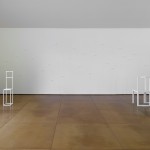Project Description
Biography
Since the late 1960s, Robert Wilson’s productions have decisively shaped the look of theater and opera. Through his signature use of light, his investigations into the structure of a simple movement, and the classical rigor of his scenic and furniture design, Wilson has continuously articulated the force and originality of his vision. Wilson’s close ties and collaborations with leading artists, writers, and musicians continue to fascinate audiences worldwide.
Robert Wilson was VAEA’s 2013 Paez Medal of Art Recipient. For more information visit the Paez Medal of Arts Archieve.
Artistic trajectory
Of Wilson’s artistic career, Susan Sontag has added “it has the signature of a major artistic creation. I can’t think of any body of work as large or as influential.” A native of Waco, Texas, Wilson was educated at the University of Texas and arrived in New York in 1963 to attend Brooklyn’s Pratt Institute. Soon thereafter, Wilson set to work with his Byrd Hoffman School of Byrds and, together with his company, developed his first signature works including King of Spain (1969), Deafman Glance (1970), The Life and Times of Joseph Stalin (1973), and A Letter for Queen Victoria (1974). Regarded as a leader of Manhattan’s then-burgeoning downtown art scene, Wilson turned his attention to large-scale opera and, with Philip Glass, created the monumental Einstein on the Beach (1976), which achieved worldwide acclaim and altered conventional notions of a moribund form.
Following Einstein, Wilson worked increasingly with major European theaters and opera houses. In collaboration with internationally renowned writers and performers, Wilson created landmark original works that were featured regularly at the Festival d’Automne in Paris, Das Berliner Ensemble, the Schaubühne in Berlin, the Thalia Theater in Hamburg, the Salzburg Festival, and the Brooklyn Academy of Music’s Next Wave Festival. At the Schaubühne he created Death, Destruction & Detroit (1979) and Death, Destruction & Detroit II (1987); and at the Thalia he presented the groundbreaking musical works The Black Rider (1991) and Alice (1992). He has also applied his striking formal language to the operatic repertoire, including Parsifal in Hamburg (1991), Houston (1992), and Los Angeles (2005); The Magic Flute (1991) and Madame Butterfly (1993); and Lohengrin at the Metropolitan Opera in New York (1998 & 2006). Wilson recently completed an entirely new production, based on an epic poem from Indonesia, entitled I La Galigo, which toured extensively and appeared at the Lincoln Center Festival in the summer of 2005. Wilson continues to direct revivals of his most celebrated productions, including The Black Rider in London, San Francisco, Sydney, Australia, and Los Angeles; The Temptation of St. Anthony in New York and Barcelona; Erwartung in Berlin; Madama Butterfly at the Bolshoi Opera in Moscow; and Wagner’s Der Ring des Nibelungen at Théâtre du Châtelet in Paris.
Wilson’s practice is firmly rooted in the fine arts and his drawings, furniture designs, and installations have been exhibited in museums and galleries internationally. Extensive retrospectives have been presented at the Centre Georges Pompidou in Paris and the Boston Museum of Fine Arts. He has mounted installations at the Stedelijk Museum in Amsterdam, London’s Clink Street Vaults, and the Guggenheim Museums in New York and Bilbao. His extraordinary tribute to Isamu Noguchi has been exhibited recently at the Seattle Art Museum, and his installations of the Guggenheim’s Giorgio Armani retrospective have traveled to London, Rome, and Tokyo.
Each summer Wilson decamps to the Watermill Center, a laboratory for the arts and humanities in eastern Long Island. The Watermill Center brings together students and experienced professionals in a multi-disciplinary environment dedicated to creative collaboration. A gala benefit and re-dedication of the reconstructed main building takes place every summer.
Wilson’s numerous awards and honors include an Obie award for direction, the Golden Lion for Sculpture from the Venice Biennale, the third Dorothy and Lillian Gish Prize for Lifetime Achievement, the Premio Europa award from Taormina Arte, two Guggenheim Fellowship awards, the Rockefeller Foundation Fellowship award, a nomination for the Pulitzer Prize in Drama, election to the American Academy of Arts and Letters, and the National Design Award for Lifetime Achievement. He has been named a Commandeur des Arts et des Lettres by the French Minister of Culture.
This information was retrieved from Robert Wilson’s official website
Biografia
Desde finales de los 1960s, las producciones de Robert Wilson han influenciado la imagen del teatro y la opera. Con su característico uso de la luz, sus investigaciones hacia la estructura del movimiento simple y el rigor clásico de sus diseños de muebles y escénica, Wilson ha articulado continuamente la fuerza y la originalidad de su visión. Las colaboraciones de Wilson con artistas, escritores, y músicos primordiales continua fascinando audiencias alrededor del mundo.
Robert Wilson fue otorgado la Medalla Páez de las Artes en el 2013. Para mas información visita Medalla Páez de las Artes.
Trayectoria artistica
Susan Sontag ha dicho: “tiene la característica de una gran creación artística” sobre la carrera artística de Robert Wilson. Nacido en Waco, Texas, Wilson estudió en la universidad de Texas y llego a la ciudad de Nueva York en 1963 donde estudió en el Pratt Institute en Brooklyn. Unos años después, Wilson listo para trabajar con su Byrd Hoffman School of Byrds y junto a su compañía, desarrolló su primeras obras características que incluyen: King of Spain (1969), Deafman Glance (1970), The Life and Times of Joseph Stalin (1973), y A Letter for Queen Victoria (1974). Considerado un líder en la escena del arte en Manhattan, Wilson dirigió su atención a la ópera a gran escala y con Philip Glass creó la obra monumental Einstein on the Beach (1976) que logro aclamación mundial y alteró las nociones convencionales de una forma moribunda .
Después de Einstein, Wilson trabajo varias veces con grandes operas y teatros europeos. En colaboración de escritores y actores internacionales, Wilson creo obras originales que fueron exhibidas regularmente en el festival d’Automne en Paris, Das Berliner Ensemble, el Schaubühne en Berlín, el Thalia Theater en Hamburgo, el Festival Salzburg, y el Festival del Brooklyn Academy of Music’s Next Wave. En el Schaubühne Wilson creó Death, Destruction & Detroit (1979) y Death, Destruction & Detroit II (1987); y en el Thalia el presentó sus musicales innovadores The Black Rider (1991) y Alice (1992). El también aplico su lenguaje formal en el repertorio de opera, incluyendo Parsifal en Hamburg (1991), Houston (1992), y Los Ángeles (2005); The Magic Flute (1991) y Madame Butterfly (1993); y Lohengrin en el Metropolitan Opera en Nueva York (1998 & 2006). Wilson recientemente completó una nueva producción, basada en un poema épico de Indonesia, llamado I La Galigo, el cual tuvo muchas giras y apareció en el festival del Lincoln Center en el verano del 2005. Wilson continua dirigiendo recreaciones de sus producciones mas celebradas incluyendo The Black Rider en Londres, San Francisco, Sídney, Australia, y Los Ángeles; The Temptation of St. Anthony en Nueva York y Barcelona; Erwartung en Berlín; Madama Butterfly en el Bolshoi Opera en Moscú; y Wagner’s Der Ring des Nibelungen en el Théâtre du Châtelet en Paris.
La practica de Wilson esta firmemente arraigado en las bellas artes y en sus dibujos, diseños de muebles, e instalaciones que han sido expuestas en museos y galerías internacionalmente. Grandes retrospectivos han sido presentados en el Centre Georges Pompidou en Paris y en el Boston Museum of Fine Arts. Ha tenido instalaciones en el Stedelijk Museum en Ámsterdam, el Clink Street Vaults en Londres, y en el museo Guggenheim en Nueva York y Bilbao. Su gran homenaje a Isamu Noguchi ha sido expuesto recientemente en el Seattle Art Museum, y sus instalaciones de Giorgio Armani del Guggenheim han viajado a Londres, Roma, y Tokio.
Cada verano Wilson va al Watermill Center, un laboratorio para las artes y humanidades en el este de Long Island. El Watermill Center junta a estudiantes y profesionales en un ambiente multidisciplinario dedicado a crear en colaboración. Una gala con beneficios y una re dedicación al edificio principal se lleva a cabo todos los veranos.
Los numerosos premios ganados por Wilson incluyen un premio Obie por dirección, el Golden Lion for Sculpture del Venice Biennale, el tercer Dorothy and Lillian Gish Prize por Lifetime Achievement, el Premio Europa de Taormina Arte, dos Guggenheim Fellowship, el premio Rockefeller Foundation Fellowship, una nominación para el premio Pulitzer en Drama, una elección al American Academy of Arts and Letters, y el National Design Award for Lifetime Achievement. Ha sido llamado un Commandeur des Arts et des Lettres por el ministerio francés de cultura.
- The Life and Death of Marina Abramovic, 2011
- The Life and Death of Marina Abramovic, 2011
- The Life and Death of Marina Abramovic, 2011
- The Life and Death of Marina Abramovic, 2011
- The Life and Death of Marina Abramovic, 2011
- Einstein on the Beach | Glass | Photographs by © Lucie Jansch (2012)
- Einstein on the Beach | Photographs by © Lucie Jansch (2012)
- Einstein on the Beach | Photographs by © Lucie Jansch (2012)
- Einstein on the Beach | Robert Wilson and Philip Glass | Photographs by © Lucie Jansch (2012)
- Zinnias: The Life of Clementine Hunter at Grand Théâtre of Les Nuits de Fourvière
- Peter Pan | Photograph © Lucie Jansch
- The Old Woman at the Brooklyn Academy of Music (BAM)
- Ibsen’s classic with the adaptation by Susan Sontag for Robert Wilson
- Deafman Glance, 1970
- Deafman Glance, 1970
- The Blacksmith’s Chair, 1999
- Sofa from Parzival, 1987. Edition of 9
- Living Rooms at Musée du Louvre
- Video Portraits of Lady Gaga at Galerie Thaddaeus Ropac | Paris, Fall 2013
- Tropical Spring at Hiram Butler Gallery in Houston, Texas.

